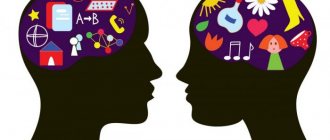Article:
Every child tends to be capricious from time to time.
Sometimes this happens for obvious reasons: tired, nervous, offended someone, faced injustice. But there are entire periods when uncontrollable and intolerable behavior is not limited to one situation, but continues for several months. Disobedience, hysterics, protests, rude speech, refusal to make contact - the list of problems can be endless. In this difficult period, it is difficult to find any logical explanation for what is happening. Those who are familiar with psychology know that age-related crises are to blame for everything.
What it is
Childhood crises are transitional stages from one stable (lytic) life period to another, characterized by a holistic change in the child’s personality, caused by the emergence of psychological new formations. To designate them, Vygotsky introduced the term “normative crises of development.”
There are many different approaches to their definition and classification (Vygotsky, Elkonin, Erikson, Leontiev, Bozhovich, etc.). Despite such diversity, they are all very similar and agree on most key points.
Psychology explains them quite simply. All children grow in leaps and bounds, during which, according to research, the brain begins to actively emit impulse waves. Scientists have yet to find out their nature and significance, but at these moments significant changes occur with mental and physical development.
Physical changes
Just yesterday he was crawling, but today he is already clumsily walking. Just yesterday I couldn’t do without outside help, but today I’m tying my shoelaces and trying to make breakfast for myself. Just yesterday my daughter was an angular, clumsy teenager, and today she has turned into a beautiful, mature girl.
Mental changes
Each age-related crisis period is accompanied by neoplasms. At 1 year - this is autonomous speech, motivating ideas, self-image. At 3 years old - primary independence, building more complex relationships, a new level of self-awareness, volitional regulation of activity. At 7 years old - arbitrariness and indirectness of actions, awareness of one’s own experiences, new social roles. At 13 - an exaggerated sense of adulthood. At 17 - professional and personal self-determination.
Why are these surges called crises? Because they represent a difficult transitional state to a new level - both physically and mentally. This process is not easy not only for parents, but most of all for the child himself. He is afraid of the dramatic changes that are happening to his body and worldview. And in response to them he begins to protest, trying to run away and hide from such a development of events. Hence the uncontrollable behavior.
Table by age
To summarize all of the above, we bring to the attention of teachers and parents a calendar of child crises, reflecting the key moments of each period.
Every age crisis is of great importance in a child’s life. In order for mental development to be harmonious and follow the right path, parents must help him overcome them.
Periodization
In psychology, there are usually five childhood crises by age:
- 1 year - transition from infancy to early childhood;
- 3 years - transition to preschool age;
- 7 years - mastering school;
- 13 years - adolescence;
- 17 years old is the beginning of early adolescence.
However, this periodization is quite arbitrary. In the works of psychologists, textbooks, and various sources one can find other interpretations of it.
For example, there is an opinion that a separate newborn crisis should include the entire first year of a baby’s life, from birth to standing. In fact, every week there can be called a transition period, characterized by sharp jumps in physical condition.
According to another point of view, the crisis periods of 13 and 17 years should be combined into one - adolescence.
In some sources, the crisis of early adolescence is excluded from this periodization, since a seventeen-year-old person can hardly be called a child in the general sense of the word.
Such discrepancies in periodization should not be scary. Their descriptions are as similar as possible.
Vygotsky on development
The age-related development of people is a rather complex process. This is especially true for the childhood stage. At any age, a person’s personality changes. Development according to Vygotsky is, first of all, the emergence of something new. That is, the stages of development, according to Vygotsky, are distinguished by specific age-related new formations, or more precisely by such qualities or properties that did not previously exist in finished form. But, as the scientist himself said, new things “do not fall from the sky.” It appears naturally. The entire process of previous development prepares a person for this.
The source of development is social society. Every step in a child's development changes the way the environment affects the child. She becomes completely different if she moves from one age stage to another. Vygotsky himself spoke of the “social situation of development.” By this term, the psychologist understood the relationship between the social environment and a person that is specific to a certain age. The child begins to interact with the social society that educates and educates him. This interaction begins to determine the developmental path that leads to the appearance of age-related neoplasms.
Views of psychologists
Many psychologists have made their contribution to the classification and description of childhood age-related crises.
Vygotsky
The foundations for understanding age-related childhood crises were laid by Lev Semyonovich Vygotsky:
- identified lytic (stable) and critical periods of development;
- called the main content of each of them the restructuring of the social situation;
- I believed that at the end of each of them, parents get a completely different child.
For the first time he put forward the idea that each critical period is a driving force for development in physical and personal terms. In this he was fully supported by other psychologists.
Leontyev
Alexey Nikolaevich Leontiev introduced the concept of leading activity (LA). In his opinion, each of the age-related crises is nothing more than a transition to a new VD:
- 1 year - object-tool training (was emotional);
- 3 - plot-role-playing;
- 7 - educational;
- 13 - intimate and personal;
- 17 - educational and professional.
The fact that every age leap is accompanied by a transition from one leading activity to another has become generally accepted. But the opinions of psychologists are divided on what kind of internal dynamics determines adolescence:
- according to Feldstein - socially useful;
- according to Davydov - socially significant;
- according to Belicheva - referentially significant;
- according to Polivanova - design.
According to Leontyev, it is the change in leading activity that is the main sign of each age-related crisis in the development of a child.
Bozovic
Lidiya Ilyinichna Bozhovich introduced the concept of neoplasm. These are the mental and social changes that occur with a child during a crisis period. They determine consciousness, attitude to the environment, interpersonal contacts, internal and external life. They are the generalized result of all mental development at the appropriate stage of life and become the basis for the formation of mental processes during the next crisis.
Neoplasms are formed at the junction of two periods and mark the completion of the previous stage of development and the beginning of the next.
Elkonin
Danil Borisovich Elkonin created his own, based on generally accepted periodization. Its foundation was his identification of two systems in which, according to the psychologist, every child develops:
- “a child is a social object”: development of the mental sphere;
- “child is a social adult”: development of the personal, motivational sphere.
Elkonin divided each stable period designated by Vygotsky into two substages. In the first, the VD is connected to one system, in the second - to another. Transitions between them are crisis leaps forward. This is what its periodization looks like:
Early childhood:
- infancy (up to one year) - crisis of 1 year (minor);
- early age (1-3 years) - crisis of 3 years (major).
Childhood:
- preschool age (4-7) - 7 years (small);
- junior school age (8-11) - 12 years (big).
Adolescence:
- younger adolescence (12-15) - 15 years (small);
- older adolescence (16-17) - 17 years (large).
Thus, for Elkonin, the age crisis of 13 years is divided into two more detailed ones - 12 and 15.
Erickson
Erik Erikson introduced the concept of identity crisis. It lies in the fact that during a problem period the child has to choose between two dilemmas. Depending on the decision made, personality development proceeds in the future either in a positive or negative way. Its periodization:
- 1 year - to trust the world around us or not?
- 3 - to be independent or to experience a constant feeling of shame for what you have done?
- 7 — reveal your initiative and organizational abilities or listen to criticism and remain in the shadows?
- 13 - be self-sufficient or insecure?
- 17 - who am I and what do I want?
According to Erikson, if the wrong path is chosen during a crisis period, this leads to disturbances in personality development.
Separation of age periods
It should be noted that the psychological age of a particular child and the calendar age, which is recorded first in the birth certificate and then in the passport, do not always coincide. It should also be noted that any period has its own characteristics of personality development, relationships with others, and mental functions. In addition, the child has some boundaries that may still shift. Thus, some children enter a certain age period earlier, and some later. The boundaries of adolescence associated with puberty are particularly blurred.
Childhood
Childhood includes all primary age periods. This is a huge era, which, in essence, prepares children for the beginning of adult life, for independent work. The peculiarity of the age periods within it is determined by the level of social, economic and cultural development of the society to which the child belongs, where he is raised and educated.
When does childhood end? Traditionally in psychology we are talking about the time from the birth of a person until he reaches the age of seven. But, naturally, modern childhood continues for a child even after he starts going to school. Of course, a junior schoolchild is still a child. By the way, many psychologists define “prolonged childhood” and adolescence separately. Whatever the opinion of psychologists, it is necessary to state the fact that real adulthood awaits a child only at the age of 16–17.
general characteristics
All age-related childhood crises have specific features.
1 year:
- with learning to walk, the available space expands;
- Autonomous speech appears (they express emotions with sounds);
- behavior is determined by impressions, and not by dependence on objects;
- the first awareness of oneself occurs (they recognize themselves in the mirror).
3 years:
- relationships with adults change;
- there is a separation of oneself from others;
- opportunities are realized;
- the need for respect and recognition arises.
7 years:
- you have to learn new rules of school life;
- The operational and technical sphere is developing at an accelerated pace;
- sociocultural experience is acquired;
- educational activities become important;
- self-regulation develops.
Teenage years:
- communication with peers comes to the fore;
- self-awareness develops - an internal sense of oneself as an individual;
- life plans are drawn up that will allow you to live independently in the future;
- self-determination appears - awareness of one’s place in human society;
- reflection, formal-logical intelligence and hypothetico-deductive thinking are formed.
It must be borne in mind that even among psychologists, periodization is quite arbitrary. You cannot take this age too literally: a crisis of 3 years does not mean at all that it will begin on your birthday and will last exactly 12 months. This criterion is quite individual. For some, the jump occurs earlier, for others later. And they can also last differently: for some, everything ends after 3 months, while others have to endure for six months or longer.
Phases
The crisis of age-related development has 3 phases of its course:
- Precritical. A person realizes the difference between objective reality and the new ideal form of his future life. Life begins to seem incomplete, a desire arises to achieve new results, to build a new future.
- Critical. This phase consists of 3 stages:
- An attempt to realize what you want in real life situations.
- Conflict stage . When trying to change his life, a person has to come into conflict with the people around him, defending his new position in life.
- Reflection. There is a revision of one’s own abilities and the formation of new internal structures of the psyche.
- Postcritical. A new real form of development of situations is being formed. Previously idealized situations become real.
Main symptoms
Age-related developmental crises are characterized by certain symptoms.
1 year:
- loud crying without tears;
- sudden movements: waving their arms, stomping their feet, shaking their heads, swinging to strike;
- excessively lively facial expressions: frowning eyebrows, pursing lips tightly, narrowing eyes;
- demanding intonations;
- dangerous curiosity when drawn to everything forbidden;
- restlessness;
- protests against the actions of adults (tearing off clothes) and the usual routine (refusing to eat);
- importunity.
3 years:
- negativism;
- obstinacy;
- stubbornness;
- riot;
- despotism;
- depreciation;
- self-will.
In addition to the above “seven stars”:
- distance from parents;
- pathological, inexplicable greed;
- harmfulness;
- jealousy;
- unreasonable aggression: they can bite, scratch, fight.
7 years:
- do not obey;
- they want to be adults: they imitate someone older, refuse to play with those who are younger;
- do not accept criticism;
- deliberately offend others.
Teenage crisis:
- hostility, conflict;
- gross violations of discipline, rules, prohibitions;
- desire for loneliness and isolation, replacement of real communication with virtual communication;
- hot temper, impulsiveness;
- decline in school performance;
- increased sensitivity to criticism.
There are also common points for all age leaps: disobedience, protests and even riots against boundaries and restrictions, closedness, loss of authority of adults and trust in them, sudden changes in mood, irritability, aggression.
Vygotsky on periods of development
The scientist identified the following two periods of child development:
- The first period of development is critical. This period suddenly appears and passes violently.
- The second period is lytic (calm).
At certain ages, in fact, development is characterized by lytic, or rather slow progression. Over a long period of time , which, as a rule, covers several years, fundamental, sharp shifts and changes do not occur at this time. And those that can be noted do not completely rebuild the child’s personality. Significant changes occur only as a result of a long-term hidden process.
Lytic path of development
Development at relatively stable ages occurs most often due to minor personality changes. Accumulating up to a certain point , they then appear spasmodically in the form of a certain age-related neoplasm. The main part of childhood is occupied by these periods. Since the development within them takes place "underground", changes in personality are clearly expressed during its comparison at the beginning and end of a specific period of time. Scientists have studied stable ages much more fully than those characterized by crises - another period of development.
Overcoming crises
To ease the worries of parents, psychologists describe in detail the features of interaction with a child during periods of crisis by year:
1 year:
- comprehensively develop;
- ensure household safety;
- teach independence;
- practice categorical prohibitions using the words “must” and “impossible.”
It is strongly not recommended at this age to wean the mother, go to work, and send the baby to kindergarten until the crisis period is over.
3 years:
- be able to switch the child’s attention;
- scold only for some specific action done here and now;
- do not operate with complex categories such as conscience, honor, duty;
- avoid “shortcuts”;
- do not force help.
7 years:
- gradually replace gaming activities with educational ones;
- provide the right to choose;
- correctly point out mistakes made;
- help with homework;
- constantly be in touch with the teacher;
- do not criticize adults in their presence;
- encourage communication with peers;
- do not compare with others;
- help in solving school problems.
Teenage years:
- look for compromises and “common ground” in all situations;
- involve in the discussion of family plans, give them the opportunity to speak out, take their opinion into account;
- maintain friendly, trusting relationships;
- be genuinely interested in their hobbies;
- delegate a number of responsibilities as an expression of trust;
- do not demand immediate fulfillment of the request: give time to think;
- control your social circle.
Despite the individual features of raising children during periods of age-related crises, there are a number of common points:
- Pay more attention to them, spend a lot of time with them.
- Change your environment more often: travel, go hiking, take part in events, walk to different places.
- Don't punish physically.
- Don’t raise your voice, don’t start open conflicts, don’t get into altercations.
- Each time, expand the circle of their rights, give them more independence, but gradually.
- Don't be led.
- Ensure a clear daily routine with mandatory physical activity.
- Discuss problem situations and draw conclusions.
- Explain to all other family members that the education system should be uniform.
- Demonstrate correct behavior by example.
Parents must take into account all these points in order not to escalate the situation and help the child survive all the crises of growing up with minimal losses.
“A quarter of a century” and new questions
Scientists attribute the next age crisis to the age period of approximately 20-25 (according to other classifications - 30) years. The already mentioned Erich Erikson [3] calls it “early maturity”, since at this time young people are already beginning to think about further fateful decisions in their lives - building a career, starting a family, and also summing up their first results.
The main issues remain the same questions of self-determination, self-actualization; the need for self-esteem arises. The famous American psychologist, founder of humanistic psychology, Abraham Maslow, considered the movement towards self-actualization to be the key to psychological health [4].
In general, he described self-actualization both as a process of personal growth and development, and as a method of this growth, and as a result of this growth. He considered the latter a privilege for people of mature age, but the psychologist attributed the start of the process itself to a young age.
The crisis of 30 years today has “crept” to an earlier age, but the current generation of 30-year-olds has been dubbed the “Peter Pan generation” for their reluctance to grow up, while 25-year-olds are experiencing a crisis of self-actualization to the fullest.
The search for oneself during this period is inevitable without comparisons with others - be it the person’s environment, or the heroes of favorite films and TV series of the same age. But here the temptation arises - to find a role model, or, on the contrary, to deny all generally accepted norms. In both cases, there cannot be a constructive solution, because sooner or later you will have to make your own choice, and the later, the greater the likelihood that the crisis will drag on.
The quarter-century mark in today's realities has shifted the problems of former 30-year-olds in their direction. Many life values and opportunities have undergone significant changes over the past 15-20 years.
Until the age of 25, young people manage to work several jobs, because the tradition of not changing employers has been forgotten for decades (except, for example, the Japanese model of society). But at the same time they remain lost - what would they still like to stop at? In this case, making lists and setting priorities can help - in life in general and in its individual areas . This way it will be easier to set specific goals and decide on the steps towards their implementation. This will be the most important step on the path to self-actualization.
In addition, during this period, the feeling of loneliness, existential vacuum and social isolation, which are associated with the above-described problems of self-actualization and self-determination, often intensifies. The main advice that psychologists give to 25-year-olds is don’t compare yourself to others.
In this aspect, you will have to comprehend Zen, because in the era of social networks, where everyone posts only the best side of their lives, such a skill can be considered a superpower. The most important thing is to understand and highlight what is necessary and interesting to you, and not imposed by your environment, friends, and family. This will help organize your thoughts and determine your future direction of movement - from reconsidering your hobbies and habits to conquering the career ladder.
A quarter-life crisis is most often a reassessment of values and summing up the first results, which do not lead to clinical depression, but are a platform for new starts and endeavors.











